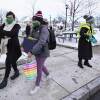The Baker administration is declaring victory over sticking to its in-school-only policy through the omicron surge, pointing to state COVID-19 data that indicates there was little infection spread in schools.
"Now that we're on the other side of omicron and the surge, it's clear that we made the right decision," Education Secretary James Peyser told GBH News. As positive COVID-19 cases continuously dropped in schools from January, he argued, the in-person-only policy was best for learners while not harming public health.
COVID-19 cases peaked the week after students returned from the holiday break, with 41,063 positive student cases reported, according to the Department of Elementary and Secondary Education.
Those numbers dropped as in-person learning continued throughout January. Positive cases in schools dropped by nearly a third by Jan. 19, then fell another third the following week. By Feb. 2, the 10,068 positive student tests showed another decrease by almost half from the prior week.
More Politics
The virus's decline in schools matched positive rates in the general public in Massachusetts. COVID-19 cases peaked this year on Jan. 10 when 28,230 new positive tests were reported to the Department of Public Health. Cases dropped 65% over the next week to 9,871 positive tests Jan. 17. By Feb. 2, just 3,673 positive cases were reported in Massachusetts.
"Schools weren't exacerbating the problem at all. They were just reflecting both the rise of the front end and the decline on the back end [of the pandemic in the general public]," Peyser said.
Determining the policy’s “success” may hinge on the definition of the word. For Peyser, the indication that there was limited transmission in schools means the policy was the right call. Teachers' unions, though, still hold that it was a failure, citing the staffing shortages they faced as staff called out sick, particularly in the peak omicron weeks of January.
Peyser said the data from the state's pool-testing and rapid at-home testing programs "is pretty definitive in showing that there is little or no transmission that's occurring in schools."
"It's because of community spread outside the school walls. So there's very little evidence to suggest that having students in person has created or exacerbated COVID health concerns broadly," Peyser said.
Teachers unions, politicians and even many students and parents had called on Gov. Charlie Baker, Peyser and Elementary and Secondary Education Commissioner Jeffrey Riley to let schools offer remote learning options if case counts or positivity rates spiked.
"The Baker-Polito administration throughout this period consistently resisted these attempts to back away from fully in-person learning, basically because of the harm it has done to students in terms of their academic progress," Peyser said.
But union leaders don't see the state keeping schools open through omicron as a win for Baker, or for students.
"From an educators' point of view, for the Baker administration to think we weren't impacted by the omicron and it was dealt with responsibly, shows how much out of touch he is," Massachusetts Teachers Association President Merrie Najimy told GBH News.
Najimy said staff shortages throughout the omicron surge were more common than not, especially in areas with higher transmission rates or lower vaccination rates in the local community.
"The larger the district, the more challenging staffing issues were. And of course, which communities are those? Primarily communities that serve students of color and families with low incomes," Najimy said.
Positive COVID-19 cases among school staff in January dropped as quickly as the rates in student cases. There were 7,351 reported positive staff tests the week ending Jan. 12, when students and staff returned from winter break. Positive tests dropped by a third the next week and fell another third by Jan. 26. By the week ending Feb. 2, positive tests had fallen another 39.1% to 1,918 total staff cases.
Boston Mayor Michelle Wu was an early critic of Baker's policy and weighed returning to remote learning at some BPS schools in January over staffing problems. The state was firm that any remote days would not count toward the required 180 days of in-school learning each school is required to provide.
"Whether or not we get credit from the state for a day of remote learning ... if a school needs to do that because of staffing issues, we are going to take that [option] if that's the safest way to administer learning that day," Wu said in January, recognizing the remote schools may have to make up for any days it closed to meet the state requirement.
Boston's now-departing superintendent Brenda Cassellius said Baker could "build a lot of good will with school superintendents" if he let them return to remote learning.
"It's good to keep the pressure on for us to be in person, but I do believe that we should have some flexibility." Cassellius said on GBH's Greater Boston the day after Wu floated the idea of going remote.
The omicron surge also proved to be less deadly than previous stages of the pandemic. Jan. 18 was the highest day for reported deaths in Massachusetts since last winter, with 85 fatalities attributed to COVID-19. On Feb. 7, 39 deaths from COVID-19 were reported. In the first surge, April 24, 2020, Massachusetts hit a single-day peak for deaths: 198 people died from COVID-19.









